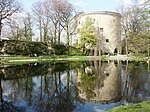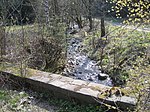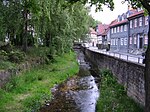Goslar Cathedral
Buildings and structures demolished in 1822Churches completed in 1051Former collegiate churchesGoslarHenry II, Holy Roman Emperor ... and 6 more
Henry III, Holy Roman EmperorImperial cathedralsMonasteries in Lower SaxonyRoman Catholic cathedrals in GermanyRoman Catholic churches in Lower SaxonyRomanesque architecture in Germany

The church known as Goslar Cathedral (German: Goslarer Dom) was a collegiate church dedicated to St. Simon and St. Jude in the town of Goslar, Germany. It was built between 1040 and 1050 as part of the Imperial Palace district. The church building was demolished in 1819–1822; today, only the porch of the north portal is preserved. It was a church of Benedictine canons. The term Dom, a German synecdoche used for collegiate churches and cathedrals alike, is often uniformly translated as 'cathedral' into English, even though this collegiate church was never the seat of a bishop.
Excerpt from the Wikipedia article Goslar Cathedral (License: CC BY-SA 3.0, Authors, Images).Goslar Cathedral
Domplatz,
Geographical coordinates (GPS) Address External links Nearby Places Show on map
Geographical coordinates (GPS)
| Latitude | Longitude |
|---|---|
| N 51.90325 ° | E 10.427805555556 ° |
Address
Stiftskirche St. Simon und Judas (Goslarer Dom)
Domplatz
38640 , Altstadt
Lower Saxony, Germany
Open on Google Maps









